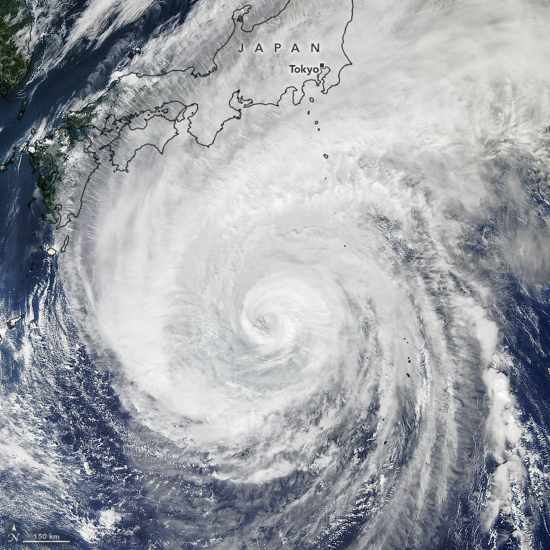According to analysts, loss development from last year’s Japanese typhoon Hagibis is not following the same path as 2018’s Jebi, with the current prognosis being that development is much better than feared.
 After the industry-wide experience with 2018’s typhoon Jebi and the resulting slow, creeping loss development, the insurance, reinsurance and insurance-linked securities (ILS) markets had been fearing similar would occur with the 2019 typhoons Hagibis and even Faxai.
After the industry-wide experience with 2018’s typhoon Jebi and the resulting slow, creeping loss development, the insurance, reinsurance and insurance-linked securities (ILS) markets had been fearing similar would occur with the 2019 typhoons Hagibis and even Faxai.
Early loss estimates diverged with Hagibis, with some suggesting it might struggle to become a $10 billion insurance and reinsurance market loss, while others said it was a $15 billion event.
That wide dispersion in early industry loss estimates didn’t help, as it put the fear into some quarters and drove higher reserves to be set and a wide-spread expectation of impending loss creep from the typhoon.
But analysts at JMP Securities said that they don’t believe this will be the case, which confirms the thoughts of others in the sector and the estimates put out by major global reinsurance players.
Having recently visited Tokyo, Japan, where they met with Japanese ceding insurers, reinsurance companies and brokers and discussed prospects for the April 1st renewals, analysts from JMP Securities said that, “Typhoon Hagibis losses are developing much better than initially feared.”
As reinsurance firms initially pegged losses somewhere around the $15 billion mark, the wider market was fearing a repeat of Jebi and a slow, steady creep up towards a market loss of around that figure.
But estimates have since then come down significantly, with much of the market now operating on an estimate in the $8 billion to $10 billion range, JMP Securities analysts said.
The analysts said that during their meetings in Tokyo, estimates consistently ranged around this level, while some of the early renewal program data for April has showed losses dropping even further in some cases.
“It is understandable why initial estimates were so high following significant creep on 2018’s Typhoon Jebi – nobody wanted to be embarrassed again. However, in a largely flooding event (vs. largely wind for Jebi) in a country that arguably has among the world’s most advanced flood defenses, it is also understandable how such overreaction proved unwarranted,” the analysts said.
Rightly, the analysts ask what re/insurers will now do with the excess loss reserves that they booked for typhoon Hagibis?
The analysts said, “Common expectation would be that we will see it released into earnings as prior year favorable development as we progress through 2020. ”
But they point out that insurance and reinsurance companies often leverage excess reserves from one line of business to compensate for worse than expected losses or development in another.
This practice, of over-reserving on certain catastrophes where they can, to only reallocate or release reserve capital to the benefit of other lines, is a practice we’ve discussed a lot in recent years, as it has become a key tool in the accounting and reporting kit for many players.
JMP’s analyst team further explain, “We also would not be surprised to see a lack of development from some companies that based their loss on a larger event, particularly those that have legacy U.S. casualty books. We would not be surprised to see that cushion covertly reallocated to prior years’ casualty reserves, especially since for the offshore reinsurance group it is difficult for the outside community to follow the trail of reserve dollars once the initial loss is established.”
So the better than feared outcome from typhoon Hagibis may be a benefit for insurance and reinsurance firms that have suffered worsening losses in their casualty books in recent quarters.
So we’re unlikely to see any big moves from those that initially reserved around the $15 billion level, as they are more likely to covertly reassign that reserve capital to offset the problems in their casualty related lines.
It’s important to note that there is an expectation of a certain level of demand surge related to typhoon Hagibis, albeit unlikely at the levels seen with Jebi.
As we previously explained, sources in Japan said demand surge will be an issue for claims from typhoon Hagibis, as a lack of claims professionals, assessors and loss adjusters has been seen to be slowing the process of insurance claims filing and is expected to inflate claims amounts.
This is also evidenced in the way some of the largest Japanese primary insurer’s ultimates are moving very slowly and have a long way to run, albeit at lower levels than originally feared.
It’s also possible that the ongoing coronavirus outbreak could have some impact on availability of adjuster, or other service providers. Something the industry will need to watch for over the coming months on a global basis.
Also read: Japanese reinsurance renewal pricing could move +50% in April.
 View all of our Artemis Live video interviews and subscribe to our podcast.
View all of our Artemis Live video interviews and subscribe to our podcast.
All of our Artemis Live insurance-linked securities (ILS), catastrophe bonds and reinsurance video content and video interviews can be accessed online.
Our Artemis Live podcast can be subscribed to using the typical podcast services providers, including Apple, Google, Spotify and more.































